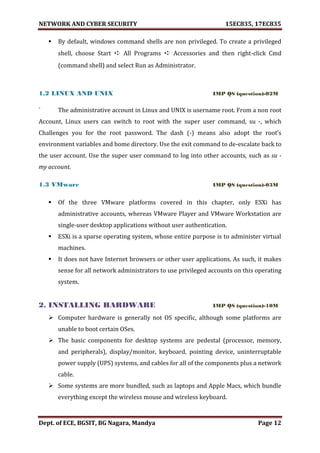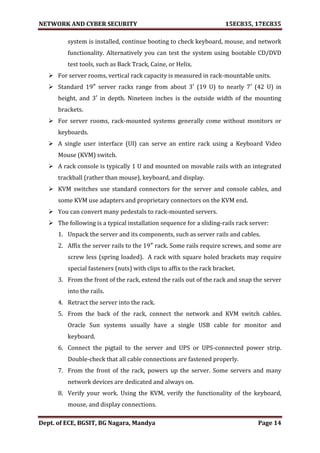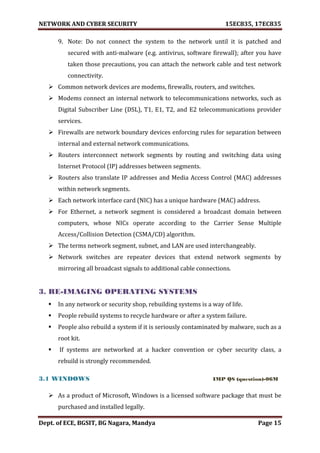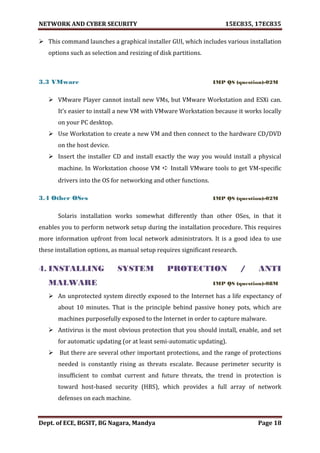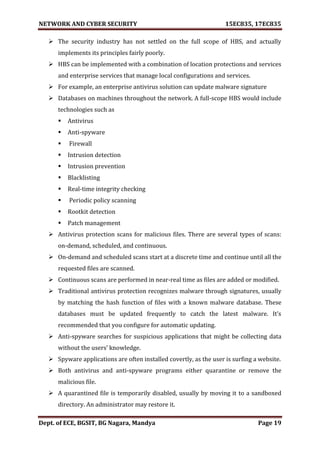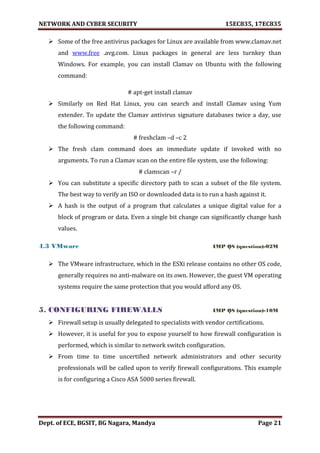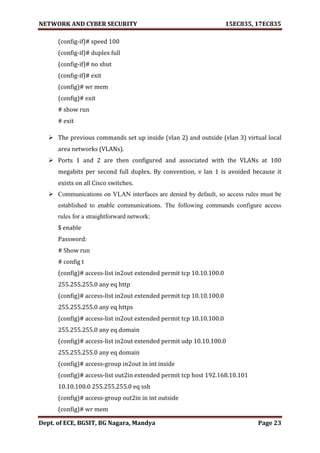The document outlines a course on Network and Cyber Security designed for 8th-semester Electronics and Communication Engineering students at B.G.S Institute of Technology. It covers various security protocols such as SSL and TLS, email security, IP security, and enterprise security frameworks, along with learning outcomes aimed at understanding and applying cyber security concepts. Key modules address security architectures, web security threats, and hands-on case studies related to cyber security management and implementation.
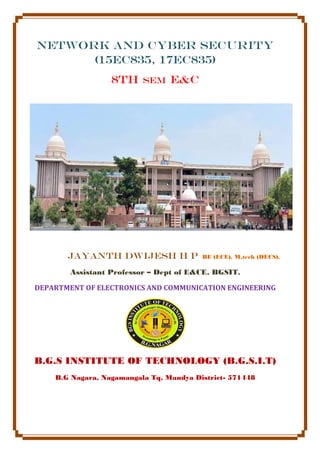



![NETWORK AND CYBER SECURITY 15EC835, 17EC835
Dept. of ECE, BGSIT, BG Nagara, Mandya Page 2
MODULE - 1
Web Security Consideration, Security socket layer (SSL), Transport layer
security, HTTPS, Secure Shell (SSH).
1. WEB SECURITY CONSIDERATION
The World Wide Web is fundamentally a client/server application running over
the Internet and TCP/IP intranets.
The web provides the following Web Security Threats which make web security a must:
The Internet is two way. Even unimportant systems like electronic publishing
systems, voice response, or fax-back are vulnerable to attacks on the Web
servers over the Internet.
The Web is increasingly serving as a platform for corporate and product
information and as the platform for business transactions. Reputations can be
damaged and money can be lost if the Web servers are subverted.
Although Web browsers, web servers are very easy to use and manage and web
content is easy to develop, the underlying software is extraordinarily complex.
This complex software may hide many potential security flaws and hence is more
vulnerable to a variety of security attacks.
A Web server can be exploited as a launching pad into the corporation’s or
agency’s entire computer complex. Once the Web server is subverted, an attacker
may be able to gain access to data and systems not part of the Web itself but
connected to the server at the local site.
Casual and untrained users’ common clients for Web-based services. Such users
are not always aware of the security risks.
1.1 WEB SECURITY THREATS JUNE/JULY-2013[8M], NOV-2020[8M]
Table 1 provides a summary of the types of security threats faced when using the
Web. One way to group these threats is in terms of passive and active attacks. Passive
attacks include eavesdropping on network traffic between browser and server and
gaining access to information on a Web site that is supposed to be restricted.](https://image.slidesharecdn.com/networkandcybersecuritymodule15ec83517ec835-210528193410/85/Network-and-cyber-security-module-15ec835-17ec835-5-320.jpg)
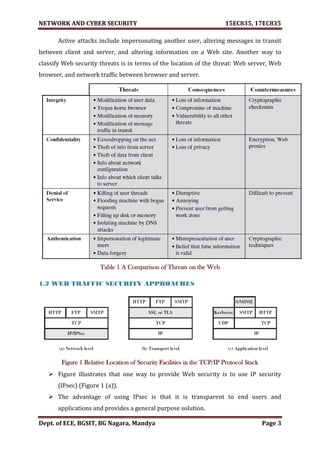
![NETWORK AND CYBER SECURITY 15EC835, 17EC835
Dept. of ECE, BGSIT, BG Nagara, Mandya Page 4
Furthermore, IPsec includes a filtering capability so that only selected traffic
need incur the overhead of IPsec processing.
Another relatively general-purpose solution is to implement security just above
TCP (Figure 1 (B)).
The foremost example of this approaches the Secure Sockets Layer (SSL) and the
follow-on Internet standard known as Transport Layer Security (TLS).
At this level, there are two implementation choices.
For full generality, SSL (or TLS) could provide as part of the underlying protocol
suite and therefore be transparent to applications.
Alternatively, SSL can embed in specific packages.
For example, Netscape and Microsoft Explorer browsers come equipped with
SSL, and most Web servers have implemented the protocol.
Application-specific security services embedded within the particular
application.
The figure shows (Figure 1 (C)). Examples of this architecture.
The advantage of this approach is that the service can tailor to the specific needs
of a given application
2. SECURE SOCKET LAYER
2.1 SSL ARCHITECTURE MAY/JUNE-2010 [10M], JUN/JULY-2011
[10M], DEC-2011[4M], DEC-2012[10M], JUNE/JULY-2013[8M], DEC/JAN-
2016[10M]
Figure 2 SSL Protocol Stack
Secure Socket Layer is designed to make use of TCP to provide a reliable end-to-
end secure service.](https://image.slidesharecdn.com/networkandcybersecuritymodule15ec83517ec835-210528193410/85/Network-and-cyber-security-module-15ec835-17ec835-7-320.jpg)
![NETWORK AND CYBER SECURITY 15EC835, 17EC835
Dept. of ECE, BGSIT, BG Nagara, Mandya Page 5
Moreover, Secure Socket Layer is not a single protocol but rather two layers of
protocols, as illustrated in Figure (2) below.
The SSL Record Protocol provides basic security services to various higher layer
protocols.
In particular, the Hypertext Transfer Protocol (HTTP), which provides the
transfer service for Web client/server interaction, can operate on top of SSL.
Three higher-layer protocols are defined as part of SSL: the Handshake
Protocol, the Change Cipher Spec Protocol, and the Alert Protocol.
Two important SSL concepts are the SSL session and the SSL connection, which
are defined in the specification as follows. DEC-2012[4M]
Connection: A connection is a transport that provides a suitable type of
service. For SSL, such connections are peer-to-peer relationships. The
connections are transient. Every connection associated with one session.
Session: An SSL session is an association between a client and a server.
Sessions are created by the Handshake Protocol. Sessions define a set of
cryptographic security parameters which can be shared among multiple
connections. Sessions are used to avoid the expensive negotiation of new
security parameters for each connection.
There a number of states associated with each session. Once a session
established, there is a current operating state for both read and write (i.e.,
receive and send)
In addition, during the Handshake Protocol, pending read and writes states
created. Upon successful conclusion of the Handshake Protocol, the pending
states become the current states
2.2 A SESSION STATE IS DEFINED BY THE FOLLOWING
PARAMETERS MAY/JUNE-2010 [10M], JUN/JULY-2011[10M], JUNE/JULY-
2019[8M], DEC-2019[8M], SEPT-2020[4M].
Session identifier: An arbitrary byte sequence chosen by the server to identify
an active or resumable session state.
Peer certificate: An X509.v3 certificate of the peer. This element of the state
may be null.](https://image.slidesharecdn.com/networkandcybersecuritymodule15ec83517ec835-210528193410/85/Network-and-cyber-security-module-15ec835-17ec835-8-320.jpg)
![NETWORK AND CYBER SECURITY 15EC835, 17EC835
Dept. of ECE, BGSIT, BG Nagara, Mandya Page 6
Compression method: The algorithm used to compress data prior to
encryption.
Cipher spec: Specifies the bulk data encryption algorithm (such as null, AES,
etc.) and a hash algorithm (such as MD5 or SHA-1) used for MAC calculation. It
also defines cryptographic attributes such as the hash size.
Master secret: 48-byte secret shared between the client and the server.
Is resumable: A flag indicating whether the session can be used to initiate new
connections.
2.3 A CONNECTION STATE IS DEFINED BY THE FOLLOWING
PARAMETERS. MAY/JUNE-2010 [10M], JUN/JULY-2011[10M], JUNE/JULY-
2019[8M], DEC-2019[4M].SEPT-2020[4M].
Server and client random: Byte sequences that are chosen by the server and
client for each connection.
Server write MAC secret: The secret key used in MAC operations on data sent
by the server.
Client write MAC secret: The secret key used in MAC operations on data sent by
the client.
Server write key: The secret encryption key for data encrypted by the server
and decrypted by the client.
Client write key: The symmetric encryption key for data encrypted by the client
and decrypted by the server.
Initialization vectors: When a block cipher in CBC mode is used, an
initialization vector (IV) is maintained for each key. This field is first initialized
by the SSL Handshake Protocol.
Sequence numbers: Each party maintains separate sequence numbers for
transmitted and received messages for each connection. When a party sends or
receives a change cipher spec message, the appropriate sequence number is set
to zero. Sequence numbers may not exceed 264
- 1.](https://image.slidesharecdn.com/networkandcybersecuritymodule15ec83517ec835-210528193410/85/Network-and-cyber-security-module-15ec835-17ec835-9-320.jpg)
![NETWORK AND CYBER SECURITY 15EC835, 17EC835
Dept. of ECE, BGSIT, BG Nagara, Mandya Page 7
2.4 SSL RECORD PROTOCOL: SSL PROTOCOL JUN/JULY-2017[10M],
JUNE-2012[10M], DEC/JAN-2019[10M], JUNE/JULY-2019[8M], SEPT-2020[6M]
The SSL Record Protocol provides two services for SSL
connections: Confidentiality and Message Integrity.
Confidentiality: The Handshake Protocol defines a shared secret key that is
used for conventional encryption of SSL payloads.
Message Integrity: The Handshake Protocol also defines a shared secret key
that is used to form a message authentication code (MAC).
Moreover, the overall operation of Record Protocol is:
Fragmentation: Each upper-layer message fragmented into blocks of 214
bytes
(16384 bytes) or less.
Compression: Compression is optionally applied. Compression must be lossless
and may not increase the content length by more than 1024 bytes.
Figure 3 SSL Record Protocol Operation
Add message authentication code(MAC): MAC calculated over the compressed
data by the following expression.
Hash (MAC_write_secret pad_2 hash (MAC_write_secret pad_1 seq _ num
SSL Compressed. type SSL Compressed. length SSL Compressed. fragment))](https://image.slidesharecdn.com/networkandcybersecuritymodule15ec83517ec835-210528193410/85/Network-and-cyber-security-module-15ec835-17ec835-10-320.jpg)
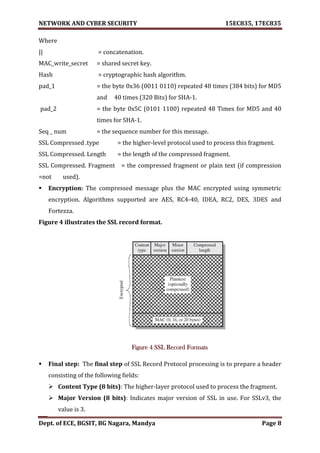
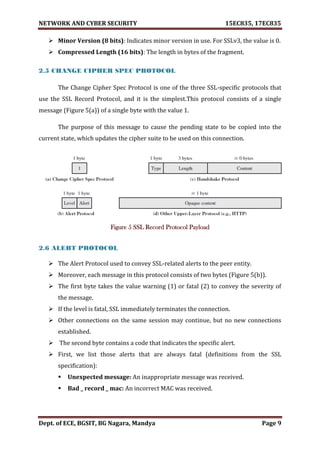
![NETWORK AND CYBER SECURITY 15EC835, 17EC835
Dept. of ECE, BGSIT, BG Nagara, Mandya Page 10
Decompression _ failure: The decompression function received improper
input (e.g., unable to decompress or decompress to greater than maximum
allowable length).
Handshake _ failure: Sender was unable to negotiate an acceptable set of
security parameters given the options available.
Illegal _ parameter: A field in a handshake message was out of range or
inconsistent with other fields.
The remaining alerts are the following.
Close _ notify: Notifies the recipient that the sender will not send any more
messages on this connection. Each party is required to send a close _ notify
alert before closing the write side of a connection.
No_ certificate: May be sent in response to a certificate request if no
appropriate certificate is available.
Bad _ certificate: A received certificate was corrupt (e.g., contained a
signature that did not verify).
Unsupported _ certificate: The type of the received certificate is not
supported.
Certificate _ revoked: A certificate has been revoked by its signer.
Certificate _ expired: A certificate has expired.
Certificate _ unknown: Some other unspecified issue arose in processing the
certificate, rendering it unacceptable.
2.7 Handshake Protocol DEC-2010 [12M], DEC-2011[8M], JAN 2015[10M],
NOV-2020[10M], SEPT-2020[8M],JULY-2019[8M]
This Handshake Protocol allows the server and client to authenticate each
other and to negotiate an encryption and MAC algorithm and cryptographic
keys to be used to protect data sent in an SSL record.
Moreover, The Handshake Protocol is used before any application data is
transmitted.
The Handshake Protocol consists of a series of messages exchanged by client
And server. All of these have the format shown in (Figure 5(c)).
A handshake message has the following format:](https://image.slidesharecdn.com/networkandcybersecuritymodule15ec83517ec835-210528193410/85/Network-and-cyber-security-module-15ec835-17ec835-13-320.jpg)

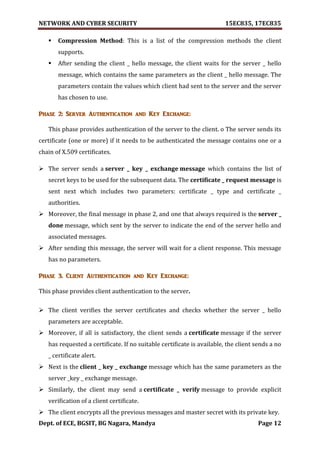


![NETWORK AND CYBER SECURITY 15EC835, 17EC835
Dept. of ECE, BGSIT, BG Nagara, Mandya Page 15
Ipad = 00110110 (36 in hexadecimal) repeated 64 times (512 bits)
opad = 01011100 (5C in hexadecimal) repeated 64 times (512 bits)
SSLv3 uses the same algorithm, except that the padding bytes are concatenated with
the secret key rather than being XORed with the secret key padded to the block
length. Moreover, The level of security should be about the same in both cases.
For TLS, the MAC calculation encompasses the fields indicated in the following
expression:
MAC(MAC_write_secret,seq_num || TLSCompressed.type ||
TLSCompressed.version || TLSCompressed.length ||
TLSCompressed.fragment)
The MAC calculation covers all of the fields covered by the SSLv3 calculation, plus
the field TLSCompressed.version,, which is the version of the protocol being
employed.
3.1 PSEUDORANDOM FUNCTION NOV-2020[6M]
TLS makes use of a pseudorandom function referred to as PRF to expand secrets
into blocks of data for purposes of key generation or validation.
Moreover, the objective is to make use of a relatively small shared secret value but
to generate longer blocks of data in a way that is secure from the kinds of attacks
made on hash functions and MACs.
The PRF is based on the data expansion function (Figure 7) given as
P _ hash (secret, seed) = HMAC _ hash (secret, A(1) || seed) ||
HMAC _hash (secret, A (2) || seed) ||
HMAC _ hash (secret, A (3) || seed) ||…
Where A () is defined as
A (0) = seed
A (i) = HMAC _ hash (secret, A (i – 1) )
PRF defined as
PRF (secret, label, seed) = P _ hash (S1, label || seed)](https://image.slidesharecdn.com/networkandcybersecuritymodule15ec83517ec835-210528193410/85/Network-and-cyber-security-module-15ec835-17ec835-18-320.jpg)
![NETWORK AND CYBER SECURITY 15EC835, 17EC835
Dept. of ECE, BGSIT, BG Nagara, Mandya Page 16
Figure 7 TLS Function P _ hash (secret, seed)
PRF takes as input a secret value, an identifying label, and a seed value and produces an
output of arbitrary length.
3.2 Alert Codes: Transport Layer Security DEC-2019[8M], NOV-2020[6M]
TLS supports all of the alert codes defined in SSLv3 with the exception of no _
certificate.
A number of additional codes defined in TLS; of these, the following are always fatal.
Record _ overflow: A TLS record was received with a payload (cipher text)
whose length exceeds 214 + 2048 bytes, or the cipher text decrypted to a length
of greater than 214 + 1024 bytes.
Unknown _ ca: A valid certificate chain or partial chain was received, but the
certificate was not accepted because the CA certificate could not be located or
could not be matched with a known, trusted CA.](https://image.slidesharecdn.com/networkandcybersecuritymodule15ec83517ec835-210528193410/85/Network-and-cyber-security-module-15ec835-17ec835-19-320.jpg)


![NETWORK AND CYBER SECURITY 15EC835, 17EC835
Dept. of ECE, BGSIT, BG Nagara, Mandya Page 19
Key _block = PRF (master _secret, "key expansion", Security Parameters.
Server _ random‖ Security Parameters. Client _random)
Until enough output has been generated. As with SSLv3, the key _block is a
function of the master _secret and the client and server random numbers, but for TLS,
the actual algorithm is different.
3.7Padding
In SSL, the padding added prior to encryption of user data is the minimum
amount required so that the total size of the data to be encrypted is a multiple of the
cipher’s block length. In TLS, the padding can be any amount that results in a total that
is a multiple of the cipher’s block length, up to a maximum of 255 bytes.
For example,
if the plaintext (or compressed text if compression is used) plus MAC plus
padding.
Length byte is 79 bytes long, then the padding length (in bytes) can be 1, 9,
17, and so on, up to 249.
A variable padding length may be used to frustrate attacks based on an
analysis of the lengths of exchanged messages.
4. HTTPS MQP[8M]
HTTPS (HTTP over SSL) refers to the combination of HTTP and SSL to
implement secure communication between aWeb browserand aWebserver.
The HTTPS capability is built into all modern Web browsers.
Its use depends on the Web server supporting HTTPS communication.
For example, search engines do not support HTTPS.
The principal difference seen by a user of a Web browser is that URL (uniform
resource locator) addresses begin with https:// rather than http://.
A normal HTTP connection uses port 80.
If HTTPS is specified, port 443 is used, which invokes SSL.
When HTTPS is used, the following elements of the communication are
encrypted:
URL of the requested document](https://image.slidesharecdn.com/networkandcybersecuritymodule15ec83517ec835-210528193410/85/Network-and-cyber-security-module-15ec835-17ec835-22-320.jpg)

![NETWORK AND CYBER SECURITY 15EC835, 17EC835
Dept. of ECE, BGSIT, BG Nagara, Mandya Page 21
At the TLS level, the proper way to close a connection is for each side to use the
TLS alert protocol to send a close notify alert.
TLS implementations must initiate an exchange of closure alerts before closing a
connection.
A TLS implementation may, after sending a closure alert, close the connection
without waiting for the peer to send its closure alert, generating an “incomplete
close”.
HTTP clients also must be able to cope with a situation in which the underlying
TCP connection is terminated without a prior close notify alert and without a
Connection: close indicator. Such a situation could be due to a programming error
on the server or a communication error that causes the TCP connection to drop.
However, the unannounced TCP closure could be evidence of some sort of attack.
So the HTTPS client should issue some sort of security warning when this occurs.
5 SECURE SHELLS (SSH) DECAUG/SEPT-2020[8M]
Secure Shell (SSH) is a protocol for secure network communications designed to
be relatively simple and inexpensive to implement.
The initial version, SSH1 was focused on providing a secure remote logon facility
to replace TELNET and Other remote logon schemes that provided no security.
SSH also provides a more general client/server capability and can be used for
such network functions as file transfer and e-mail.
A new version, SSH2, fixes a number of security flaws in the original scheme.
SSH2 is documented as a proposed standard in IETF RFCs 4250 through 4256.
SSH client and server applications are widely available for most operating
systems.
It has become the method of choice for remote login and X tunnelling and is
rapidly becoming one of the most pervasive applications for encryption
technology outside of embedded systems.
SSH is organized as three protocols that typically run on top of TCP ( above
Figure 8 ):
Transport Layer Protocol: Provides server authentication, data
confidentiality, and data integrity with forward secrecy. The transport layer
may optionally provide compression.](https://image.slidesharecdn.com/networkandcybersecuritymodule15ec83517ec835-210528193410/85/Network-and-cyber-security-module-15ec835-17ec835-24-320.jpg)

![NETWORK AND CYBER SECURITY 15EC835, 17EC835
Dept. of ECE, BGSIT, BG Nagara, Mandya Page 23
downside is that the database of name-to-key associations may become
burdensome to maintain.
2. The host name-to-key association is certified by a trusted certification
authority (CA). The client only knows the CA root key and can verify the
validity of all host keys certified by accepted CAs. This alternative eases the
maintenance problem, since ideally, only a single CA key needs to be securely
stored on the client. On the other hand, each host key must be appropriately
certified by a central authority before authorization is possible.
5.1.2 Packet Exchange
SSH Transport Layer Protocol Packet Exchanges MQP [8M]
Figure (9) illustrates the sequence of events in the SSH Transport Layer Protocol.
First, the client establishes a TCP connection to the server. This is done via the TCP
protocol and is not part of the Transport Layer Protocol. Once the connection is
established, the client and server exchange data, Referred to as packets, in the data field
of a TCP segment.
The SSH Transport Layer packet exchange consists of a sequence of steps (Figure
9).
1. The first step, the identification string exchange, begins with the client sending
a packet with an identification string of the form:
SSH-protoversion-software version SP comments CR LF
Where SP, CR, and LF are space character, carriage return, and line feed,
respectively
2. Next comes algorithm negotiation. Each side sends an SSH_MSG_KEXINIT
containing lists of supported algorithms in the order of preference to the sender.
There is one list for each type of cryptographic algorithm. The algorithms include
key exchange, encryption, MAC algorithm, and compression algorithm.
Below Table (2) shows the allowable options for encryption, MAC, and
compression.
3. The next step is key exchange. As a result of these steps, the two sides now
share a master key K. In addition, the server has been authenticated to the client,
because the server has used its private key to sign its half of the Diffie-Hellman](https://image.slidesharecdn.com/networkandcybersecuritymodule15ec83517ec835-210528193410/85/Network-and-cyber-security-module-15ec835-17ec835-26-320.jpg)

![NETWORK AND CYBER SECURITY 15EC835, 17EC835
Dept. of ECE, BGSIT, BG Nagara, Mandya Page 25
Figure 9: SSH Transport Layer Protocol Packet Exchanges
5. The final step is service request. The client sends an SSH_MSG_SERVICE_
REQUEST packet to request either the User Authentication or the Connection
Protocol. Subsequent to this, all data is exchanged as the payload of an SSH
Transport Layer packet, protected by encryption and MAC.
SSH Transport Layer Protocol Packet Formation
JUNE/JULY-2019 [8M]
Each packet is in the following Format (Figure 10).
Packet length: Length of the packet in bytes, not including the packet length
and MAC fields.
Padding length: Length of the random padding field.](https://image.slidesharecdn.com/networkandcybersecuritymodule15ec83517ec835-210528193410/85/Network-and-cyber-security-module-15ec835-17ec835-28-320.jpg)



![NETWORK AND CYBER SECURITY 15EC835, 17EC835
Dept. of ECE, BGSIT, BG Nagara, Mandya Page 29
server receives this message, it checks whether the supplied key is acceptable for
authentication and, if so, it checks whether the signature is correct.
2. Password: The client sends a message containing a plaintext password, which is
protected by encryption by the Transport Layer Protocol.
3. Host based: Authentication is performed on the client’s host rather than the
client itself. Thus, a host that supports multiple clients would provide
authentication for all its clients. This method works by having the client send a
signature created with the private key of the client host. Thus, rather than
directly verifying the user’s identity, the SSH server verifies the identity of the
client host—and then believes the host when it says the user has already
authenticated on the client side.
5.3 Connection Protocol
The SSH Connection Protocol runs on top of the SSH Transport Layer Protocol
and assumes that a secure authentication connection is in use. That secure
authentication connection, referred to as a tunnel, is used by the Connection Protocol to
multiplex a number of logical channels.
5.3.1 Channel Mechanism
SSH Connection Protocol Message Exchange JAN-2020 [6M]
Figure 11 provides an example of Connection Protocol Message Exchange
1. All types of communication using SSH, such as a terminal session, are supported
using separate channels.
2. Either side may open a channel. For each channel, each side associates a unique
channel number, which need not be the same on both ends.
3. Channels are flow controlled using a window mechanism.
4. No data may be sent to a channel until a message is received to indicate that
window space is available. The life of a channel progresses through three stages:
opening a channel, data transfer, and closing a channel.
5. When either side wishes to open a new channel, it allocates a local number for
the channel and then sends a message of the form:
Byte SSH_MSG_CHANNEL_OPEN
String channel type
Uint32 sender channel](https://image.slidesharecdn.com/networkandcybersecuritymodule15ec83517ec835-210528193410/85/Network-and-cyber-security-module-15ec835-17ec835-32-320.jpg)

![NETWORK AND CYBER SECURITY 15EC835, 17EC835
Dept. of ECE, BGSIT, BG Nagara, Mandya Page 31
block of data. These messages, in both directions, may continue as long as the
channel is open.
8. When either side wishes to close a channel, it sends a SSH_MSG_CHANNEL_
CLOSE message, which includes the recipient channel number.
5.3.2 Channel Types
Four channel types are recognized in the SSH Connection Protocol specification.
Session: The remote execution of a program. The program may be a shell, an
application such as file transfer or e-mail, a system command, or some built-in
subsystem. Once a session channel is opened, subsequent requests are used to
start the remote program.
X11: This refers to the X Window System, a computer software system and
network protocol that provides a graphical user interface (GUI) for networked
computers. X allows applications to run on a network server but to be displayed
on a desktop machine.
Forwarded-tcpip: This is remote port forwarding, as explained in the next
subsection.
Direct-tcpip: This is local port forwarding, as explained in the next subsection.
5.3.3 Port Forwarding NOV-2020[8M],SEP-2020[M]
One of the most useful features of SSH is port forwarding. In essence, port
forwarding provides the ability to convert any insecure TCP connection into a
secure SSH connection. This is also referred to as SSH tunnelling. t.
A port is an identifier of a user of TCP.
So, any application that runs on top of TCP has a port number.
Incoming TCP traffic is delivered to the appropriate application on the basis of
the port number. An application may employ multiple port numbers.
Figure 12 illustrates the basic concept behind port forwarding.
We have a client application that is identified by port number x and a server
application identified by port number y.
At some point, the client application invokes the local TCP entity and requests a
connection to the remote server on port y.](https://image.slidesharecdn.com/networkandcybersecuritymodule15ec83517ec835-210528193410/85/Network-and-cyber-security-module-15ec835-17ec835-34-320.jpg)
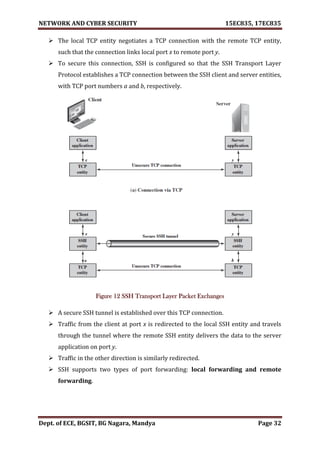




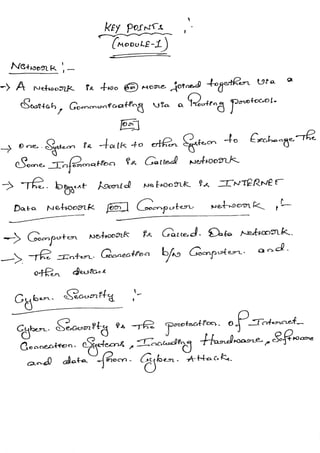
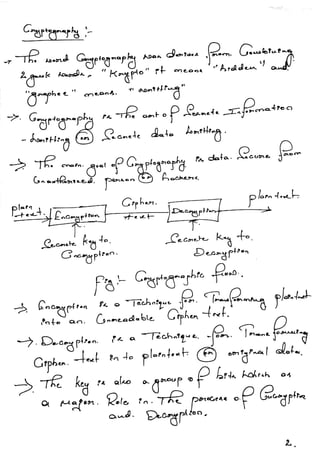
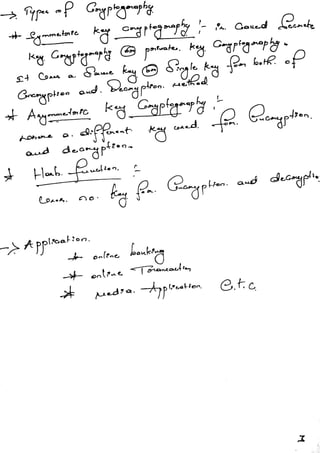




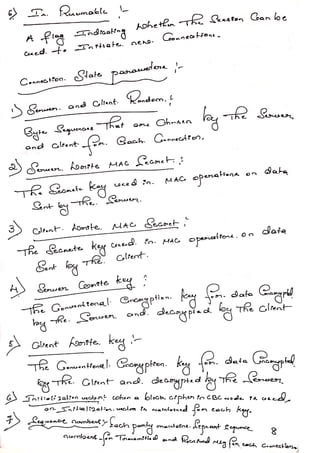










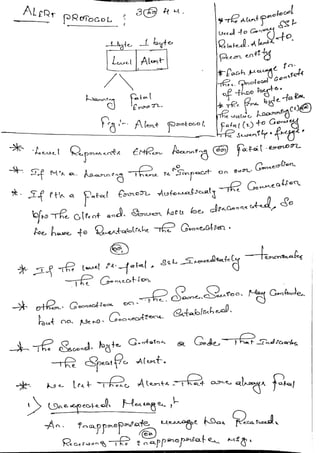
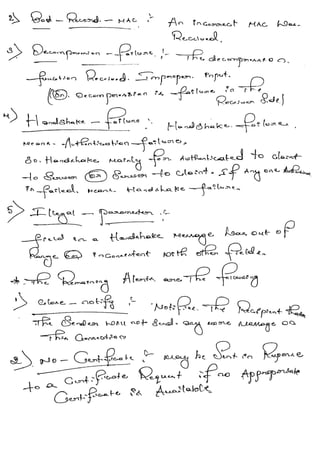




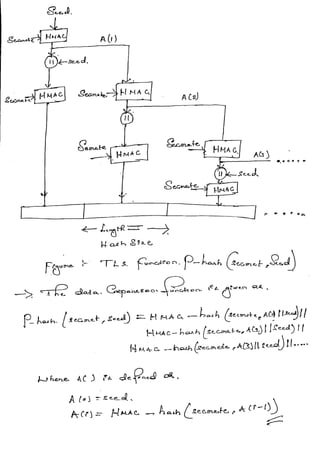


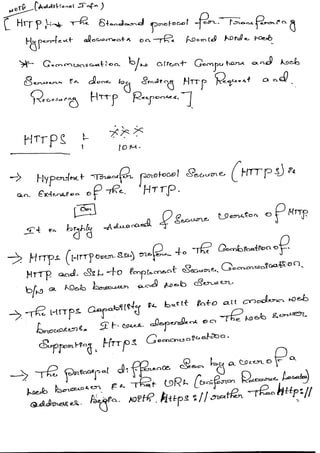




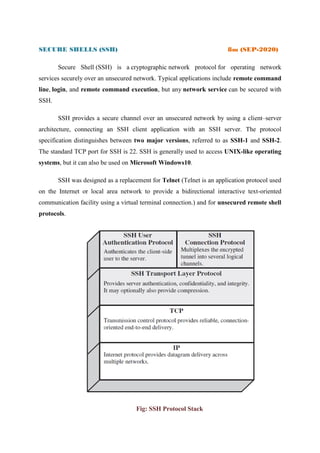
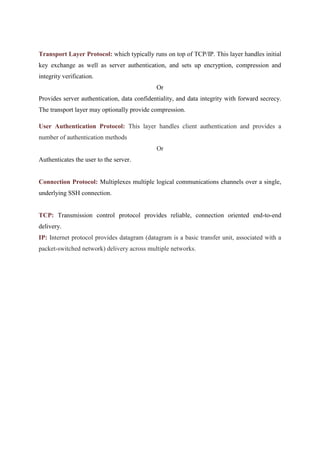








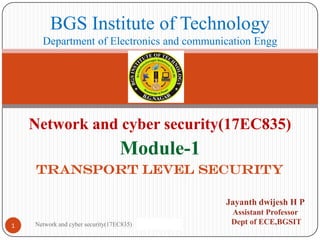








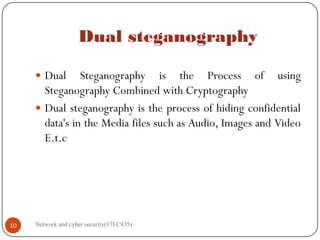
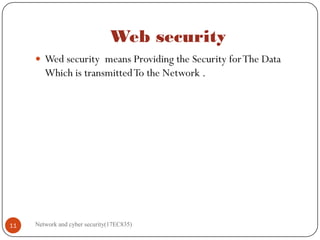







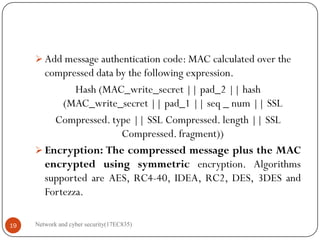
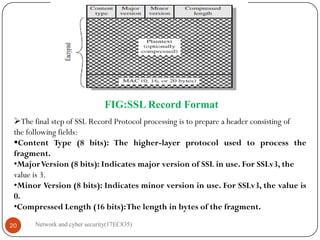


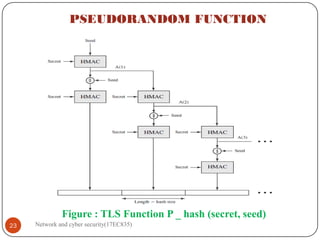

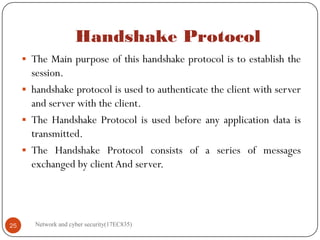

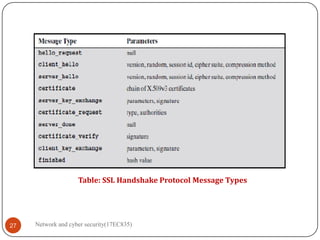
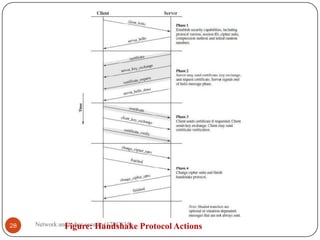





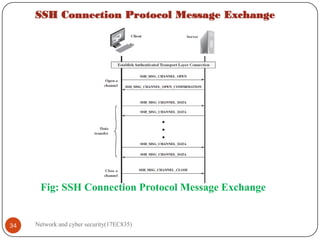
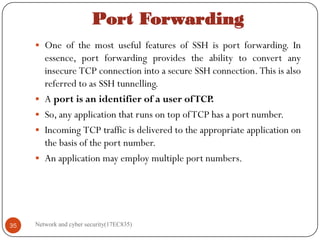

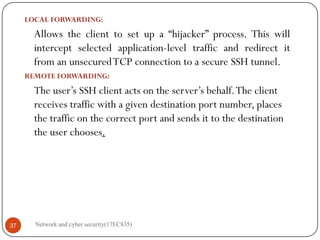
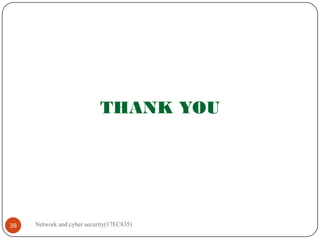


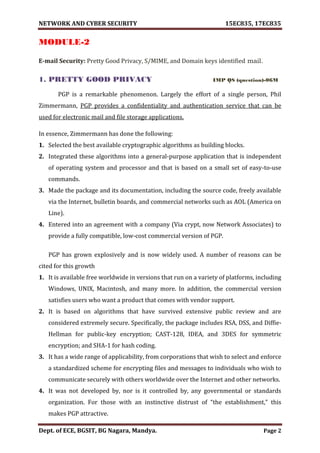
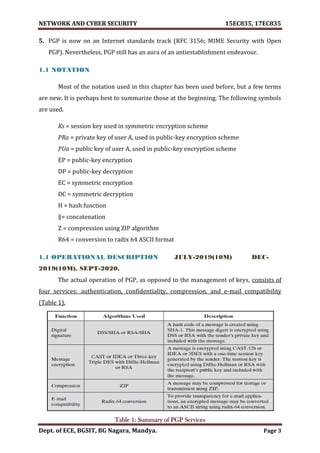


![NETWORK AND CYBER SECURITY 15EC835, 17EC835
Dept. of ECE, BGSIT, BG Nagara, Mandya. Page 6
1.1.4 Compression
As a default, PGP compresses the message after applying the signature but before
encryption. This has the benefit of saving space both for e-mail transmission and for file
storage. The placement of the compression algorithm, indicated by Z for compression
and 𝑍−1
for decompression in figure (1, 2 &3) critical. The compression algorithm used is
ZIP.
1. The signature is generated before compression for two reasons:
a. so that one can store only the uncompressed message together with signature
for later verification
b. Applying the hash function and signature after compression would constrain all
PGP implementations to the same version of the compression algorithm as the
PGP compression algorithm is not deterministic
2. Message encryption is applied after compression to strengthen cryptographic
security. Because the compressed message has less redundancy than the original
plaintext, cryptanalysis is more difficult.
1.1.5 PGP Operation – Email Compatibility DEC-2019(10M), SEPT-
2020(10M), JULY-2019[10M]
When PGP is used, at least part of the block to be transmitted is encrypted, and thus
consists of a stream of arbitrary 8-bit octets.
However many electronic mail systems only permit the use of ASCII text. To
accommodate this restriction, PGP provides the service of converting the raw 8-
bit binary stream to a stream of printable ASCII characters.
It uses radix-64 conversion, in which each group of three octets of binary data is
mapped into four ASCII characters. This format also appends a CRC to detect
transmission errors. The use of radix 64 expands a message by 33%, but still an
overall compression of about one- third can be achieved.
NOTE:- Figure 1 Authentication only, Figure 2 Confidentiality only, Figure 3 Confidentiality
and authentication = PGP Cryptographic Functions](https://image.slidesharecdn.com/networkandcybersecuritymodule15ec83517ec835-210528193410/85/Network-and-cyber-security-module-15ec835-17ec835-126-320.jpg)





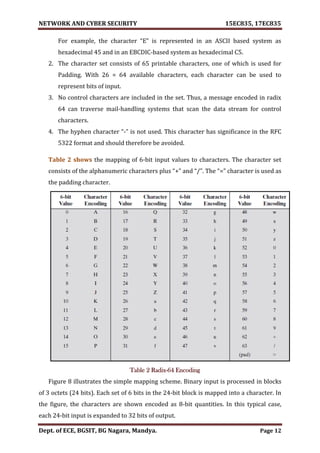
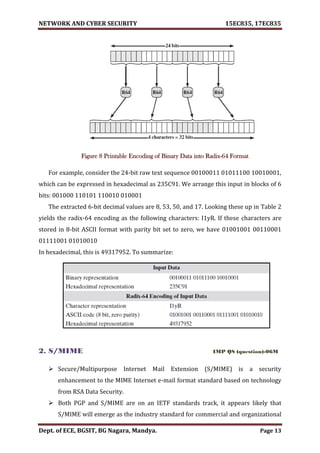
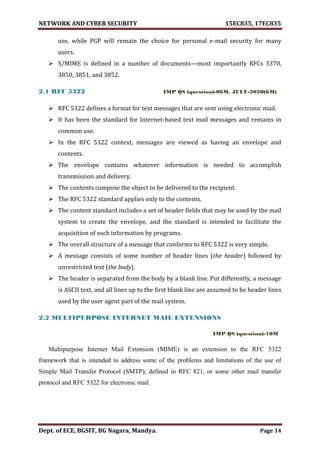

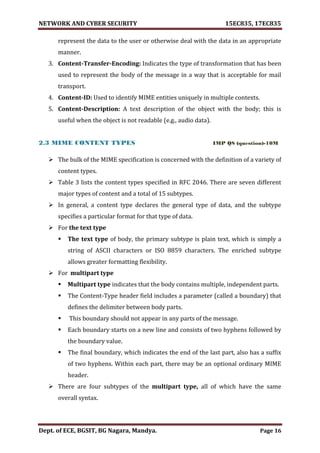







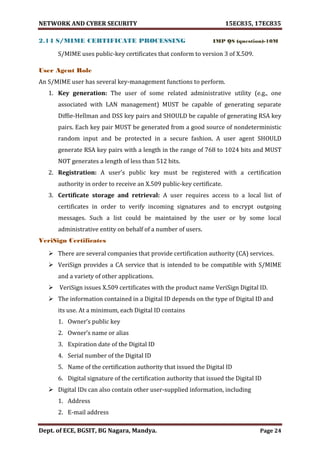
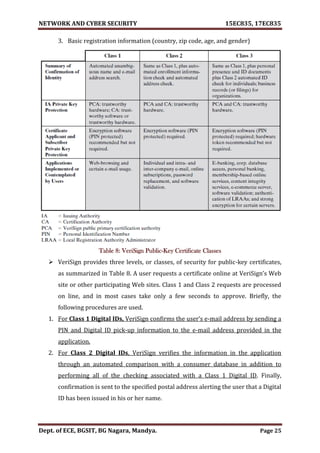





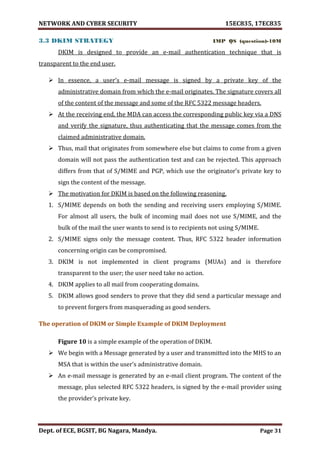

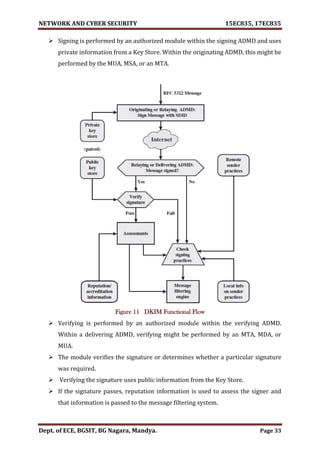

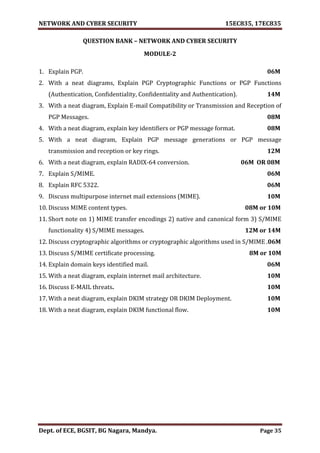

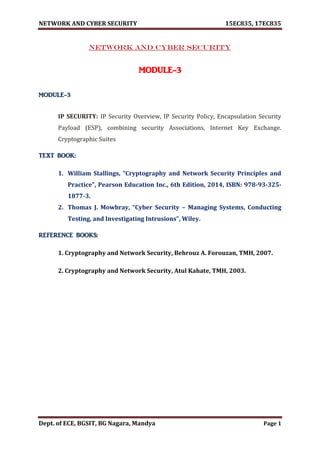


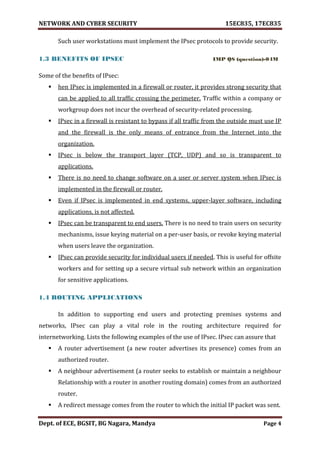




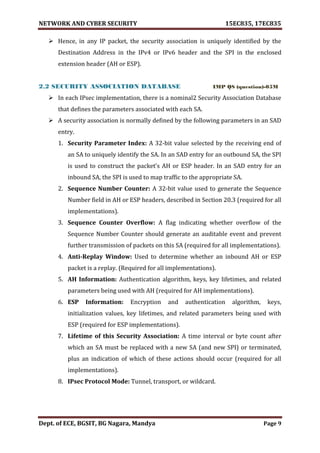



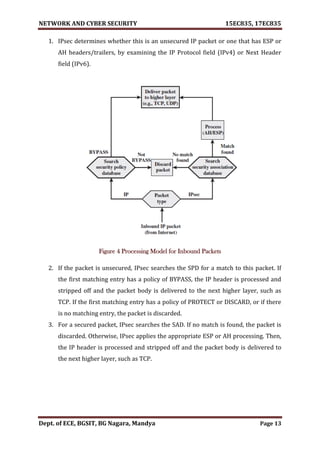
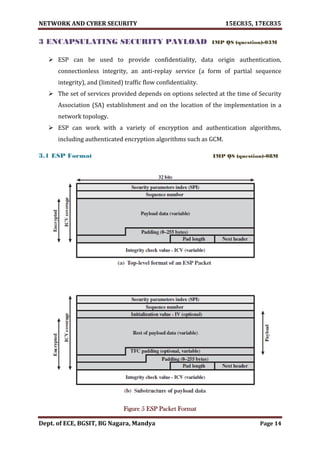


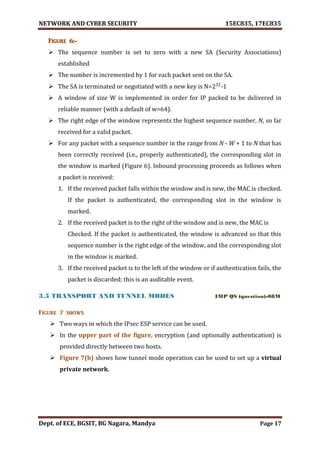

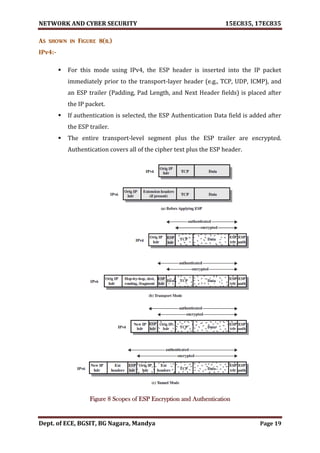





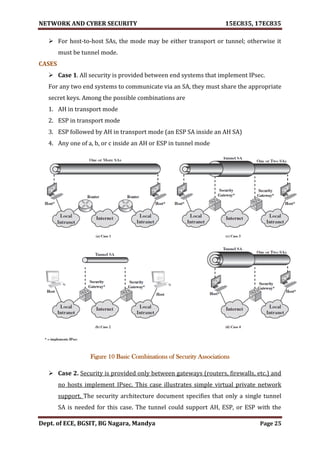
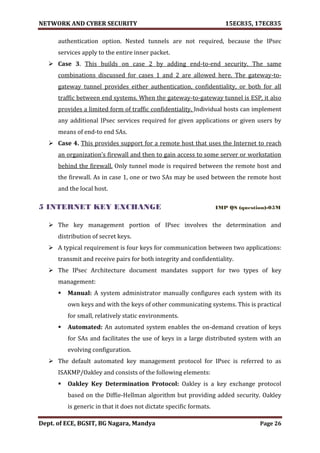
![NETWORK AND CYBER SECURITY 15EC835, 17EC835
Dept. of ECE, BGSIT, BG Nagara, Mandya Page 27
Internet Security Association and Key Management Protocol (ISAKMP):
ISAKMP provides a framework for Internet key management and provides
the specific protocol support, including formats, for negotiation of security
attributes.
5.1 KEY DETERMINATION PROTOCOL
IKE key determination is a refinement of the Diffie-Hellman key exchange
algorithm.
The Diffie-Hellman involves the following interaction between users A and B.
There is prior agreement on two global parameters: q, a large prime number;
And , a primitive root of q.
A selects a random integer XA as its private key and transmits to B its public key
YA= XAmod q.
Similarly, B selects a random integer XB as its private key and transmits to A its
public key YB = XB mod q. Each side can now compute the secret session key:
The Diffie-Hellman algorithm has two attractive features:
Secret keys are created only when needed. There is no need to store secret
keys for a long period of time, exposing them to increased vulnerability.
The exchange requires no pre-existing infrastructure other than an
agreement on the global parameters.
However, there are a number of weaknesses to Diffie-Hellman, as pointed out in
[HUIT98].
It does not provide any information about the identities of the parties.
It is subject to a man-in-the-middle attack, in which a third party C
impersonates B while communicating with A and impersonates A while
communicating with B. Both A and B end up negotiating a key with C, which
can then listen to and pass on traffic. The man-in-the-middle attack proceeds
as
1. B sends his public key YBin a message addressed to A (see Figure 11).
2. The enemy (E) intercepts this message. E saves B’s public key and sends a
message to A that has B’s User ID but E’s public key YE. This message is sent
in such a way that it appears as though it was sent from B’s host system. A](https://image.slidesharecdn.com/networkandcybersecuritymodule15ec83517ec835-210528193410/85/Network-and-cyber-security-module-15ec835-17ec835-183-320.jpg)


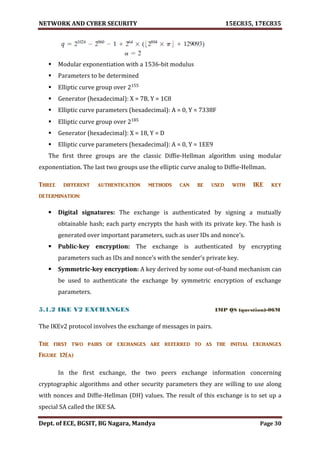




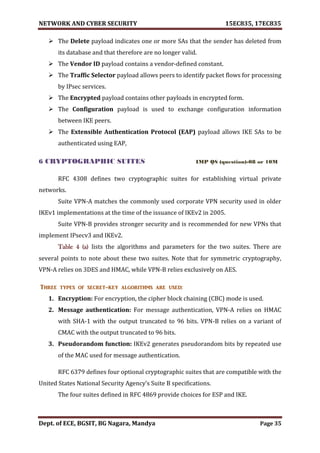
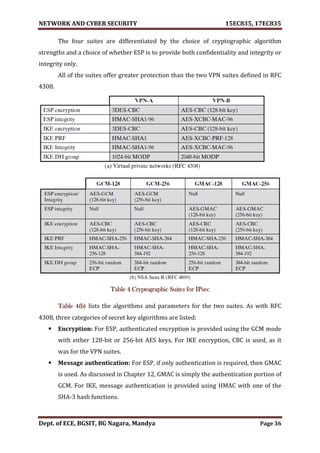




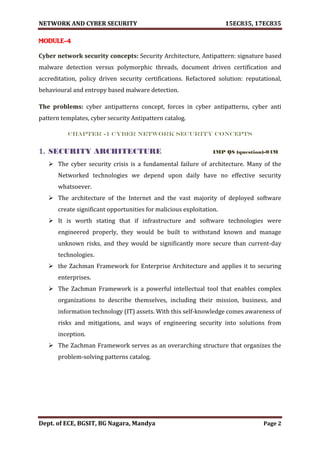
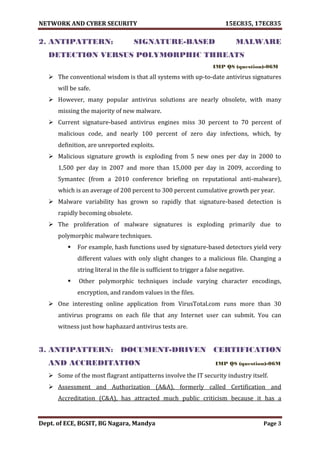









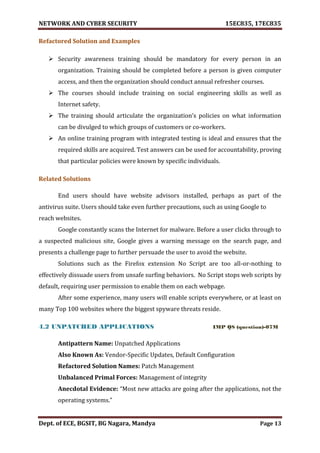
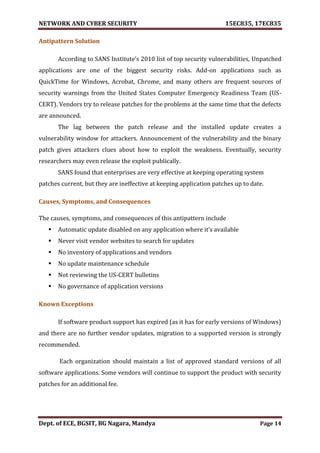

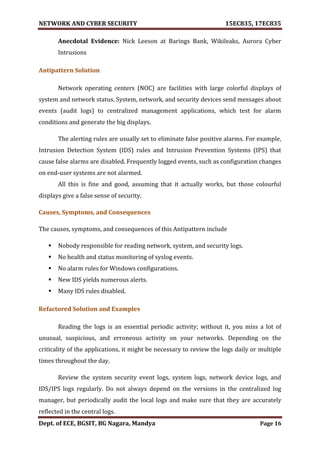
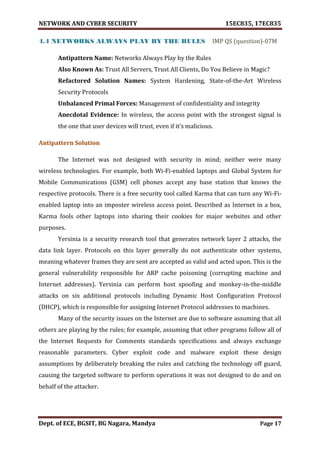




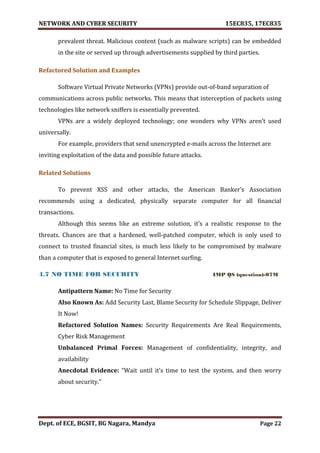


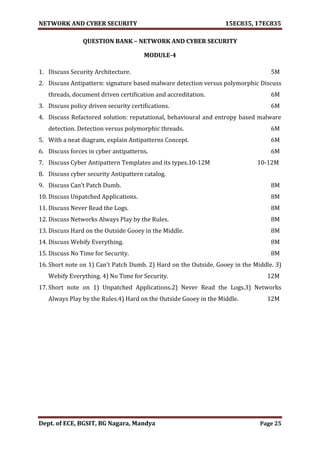



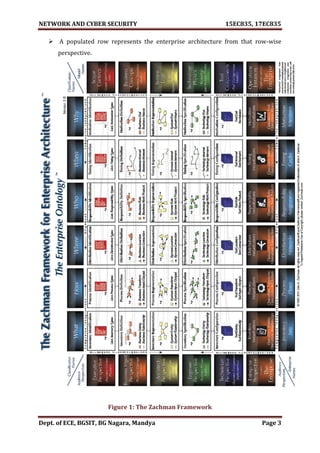

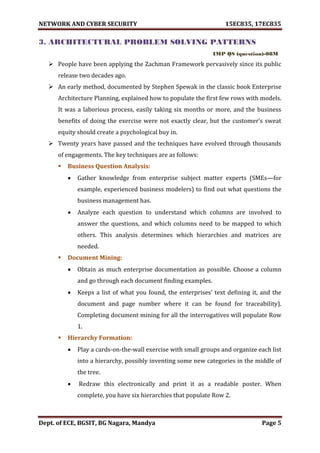


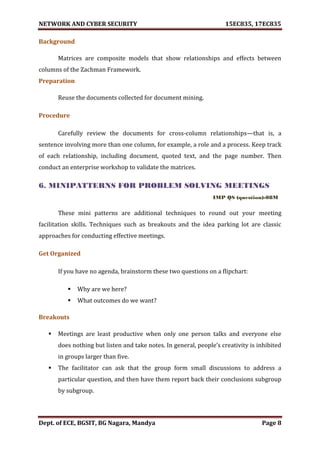

![NETWORK AND CYBER SECURITY 15EC835, 17EC835
Dept. of ECE, BGSIT, BG Nagara, Mandya Page 10
New techniques are constantly being developed. Beyond problem solving there
is a new generation of techniques based upon possibility thinking. More than 60
possibility-thinking methods have been published (Holman & Devane, 2007). Using
techniques such as The Circle Way, The World Cafe, Open Space, and Appreciative
Inquiry, groups are encouraged to explore new possibilities based upon organizational
strengths rather than dwelling on problems and weaknesses.
CHAPTER -2 Case study
1. MANAGING ADMINISTRATOR AND ROOT ACCOUNTS
IMP QS (question)-06M
As a network administrator, you are granted a privileged user account on many
networked systems and devices.
Privileged or administrative accounts can exercise unlimited authority on your
systems and networks. Some key best practices for managing privileged accounts
include:
All users, including network administrators, should normally use
unprivileged, non administrative accounts.
Administrative operations should be effectively separated from other user
activities.
For example, e‑mail and Internet browsing should not be performed using
administrative accounts or while managing devices/services remotely. Careful
use of legitimate websites to perform software updates and upgrades is
acceptable. These policies are essential for network security for the following
reasons:
Logged in with a privileged account, a user receives an unexpected but
authentic-looking e‑mail and opens its attachment, which installs a root kit. A
root kit is malicious software that takes complete control of an account for a
remote attacker. By compromising a privileged account, the entire system
(and possibly the entire local area network [LAN]), all its accounts,
computing power, and data are compromised.
A network administrator, logged in as root super user, visits a drive-by
malware website; a root kit is installed unknowingly. Now the attackers have
administrative privileges on the network.](https://image.slidesharecdn.com/networkandcybersecuritymodule15ec83517ec835-210528193410/85/Network-and-cyber-security-module-15ec835-17ec835-231-320.jpg)

